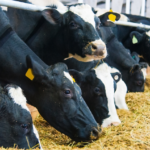
VIDEO: Are GM Crops Harming Our Environment?
We gathered questions from consumers about foods grown using genetically-modified organisms. From those questions, we developed a five-part video series to address the many angles of this topic, including general information, food safety, nutrition, labeling and environmental impacts.
This video focuses on the impacts GM crops have on the environment. A west-coast mom, Karri Hammerstrom, asks tough questions of environmental scientist Dr. Cecilia Chi-Ham from the Public Intellectual Property Resource for Agriculture at the University of California-Davis.
We’re interested in understanding what additional questions you have for Dr. Cecilia. Feel free to submit questions below.
What did other experts have to say about environmental impacts of genetically modified crops?
Don’t GMO crops use a lot of pesticides and other chemicals?
Dr. Martina Newell-McGloughlin:
This is a good question. An economists’ study analyzing GMO crops a couple years ago determined that pesticides’ footprint is down by about 35% for corn and 25% for cotton. In addition, there is a reduction in carbon dioxide emissions of 286 million kilograms. This is because herbicide-tolerant seeds (which create herbicide-tolerant plants) allow farmers to practice no-till agriculture – that is, they don’t have to plow the land (which causes carbon dioxide to be released). This also means the soil integrity is retained so the organic matter is much healthier, there is less soil compaction because you’re not driving over the land, and water usage is better because it is being retained in the soil. As well, because you’re not driving over the land, fuel usage is lower. In fact, fuel usage is estimated to be about 20 gallons less per acre.
Dr. Wayne Parrott:
No farmer likes to buy and use pesticides just for the sake of it – every chemical bought reduces the farmer’s profit. Because of insecticide-resistant corn and cotton, we’re not using as many insecticides in the environment as we were before, nor are we losing as much pre-harvest yield as we were before. Lower insecticide use and less yield loss translate into additional profits. The reduction in the amount of herbicides used has not been as dramatic as the decrease in insecticide use, but the type of herbicides being used now are very different from those used in the past. They are much more environmentally friendly, so even if the amount has not changed much, the environmental impact has decreased significantly.
Dr. Peggy Lemaux:
In reality, having crops that can tolerate herbicides and pest attacks increases pest management options and can also reduce the number and strength of pesticide applications. Growth of GM herbicide-tolerant crops also allows topical application of herbicides to crops and weeds, which replaces mechanical removal of weeds, which can damage crops. Reducing mechanical tillage lowers fuel consumption and helps conserve soils prone to erosion and compaction.
How are GMOs regulated?
Dr. Newell-McGloughlin:
In the U.S., GMOs are more highly regulated than any other methods to introduce traits into crops today. Three principal agencies that regulate are:
-
Food and Drug Administration (FDA)
-
USDA Animal and Plant Health Inspection Service (USDA-APHIS)
-
Environmental Protection Agency (EPA)
The primary body that regulates the commercialization of GMOs is USDA-APHIS. This is a lengthy and expensive process. For most regulation, it takes several years to determine the status. This process has actually inhibited development of many crops that could replace older, less safe, less environmentally friendly techniques.
Dr. Lemaux:
The FDA is responsible for the safety and labeling of foods and animal feeds from all crops, including those that are genetically modified. The EPA evaluates food safety and environmental issues associated with new pesticides. The EPA also oversees GMO plants, for example, in cases where a small part of a pest is used to develop the GMO crop. And USDA-APHIS oversees environmental consequences and safety of planting and field-testing of GMO plants. Their role is to ensure that field tests of GMO crops are conducted under specified conditions and that any unusual occurrences are reported. Not every GMO crop will be overseen by all three agencies; however, all three agencies have the legal power to ask for immediate removal from the market of any product, if valid scientific data show a safety concern for consumers or the environment.
Dr. Alison Van Eenennaam:
The FDA is responsible for the regulatory oversight of genetically engineered animals. For all human and animal drug applications, the FDA requires that the company interested in selling a product provide them with the food and safety data to support their contention that the product is safe. They consult with the company as to the types of studies that will be required to show that it’s safe. The company then carries out those studies, and the FDA independently reviews the data and comes to a conclusion as to whether or not the product is safe. Some people think the FDA should not use company data to prove safety, but requiring the FDA to produce that data would shift the cost of drug development from the private to the public sector.
Are GMOs considered sustainable?
Dr. Van Eenennaam:
To me, sustainability is a three-legged stool that needs to balance economic, environmental and social goals. There are some GM applications that have the potential to satisfy all three of these sustainability goals concurrently. For example, GM animals that are disease-resistant are less expensive to raise, have improved animal welfare, and have decreased need for the use of therapeutic antibiotics. Improving production efficiency through improved animal health would also have the added environmental benefit of decreasing the carbon footprint per pound of product that is produced.
Dr. Parrott:
The 3 pillars of sustainability are people, profit and planet. From that perspective, they meet the profit criterion, or farmers would not be using them to the extent they are. They meet the planet criterion, as GMOs are lowering the agricultural footprint- there is less chemical damage, less erosion, less greenhouse gasses and less fossil fuel use. Finally, they improve the quality of life for people. My grandfather was a farmer, and he would much rather have spent his Sunday afternoons watching football with the grand kids; instead, he had to spend it on the tractor plowing and spraying. The fact that GMO agriculture requires a lot less labor has also contributed to its popularity among farmers.
Do GM crops create superweeds and pesticide resistant bugs? If so, does this mean farmers have to apply more toxic chemicals to the crops?
Dr. Bruce Chassy:
I’ll address this in two parts – first: superweeds. It is inaccurate to call emergence of a single herbicide resistance a “superweed.” A superweed (by definition) would actually be resistant to all or at least many herbicides. Resistance has occurred with many herbicides used on non-GE crops. Fortunately, that has not yet occurred with GM crops; multiple herbicide-resistant weeds have emerged in conventional crops through poor stewardship of herbicides. Where we have seen resistance to herbicides used in GE crops, (less than 1 percent of land planted with GM herbicide-tolerant crops), alternative herbicides are still effective. The key requirement to minimize the emergence of resistance to the herbicides used on crops is careful management.
Second: toxic chemicals. Comprehensive data from all over the world demonstrates that planting GE crops has significantly reduced the amount of pesticides used on crops (Brookes and Barfoot, 2010). In addition, it has allowed a shift to far less toxic herbicides that are not persistent in the environment. The claim that more toxic chemicals are used because of GE crops is not supported by the evidence. One of the major reasons that farmers choose to pay more for GE seeds is that they end up paying less for chemicals, fuel, and labor. They also suffer less soil compaction in their fields, less soil erosion and water loss, and there are far less greenhouse gas emissions from their fields. If no-till methods that are facilitated by planting GE crops are used, it also improves soil organic carbon content.
Dr. Parrott:
There is evidence that rootworms are becoming resistant, but they are not there yet, and they may never get there. The other pests are not showing such signs. Also, ‘superweeds’ is a term coined to purposely exaggerate a problem, and it refers to a weed that has become resistant to an herbicide. By that definition, herbicides have been creating “superweeds” since they came into use after WWII. Any given herbicide has a lifespan of some 10 years before the weeds catch up. The worst case scenario is we go back to the chemicals we have used before. The claim that we will go to a more toxic agriculture than we had before is not valid.
Still have questions? Submit them below!
“The thunderstorm” by Tez Gooyer is licensed under CC BY ND.

























